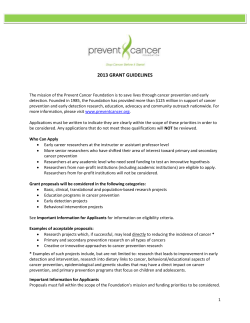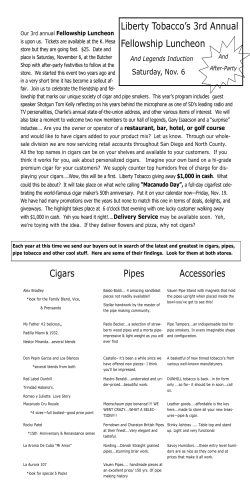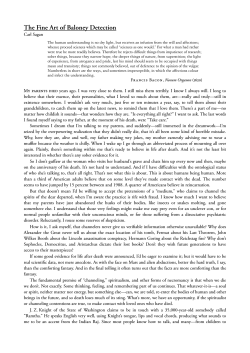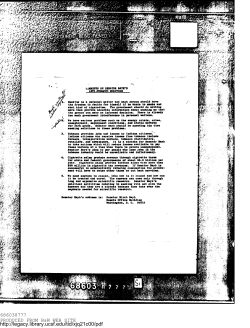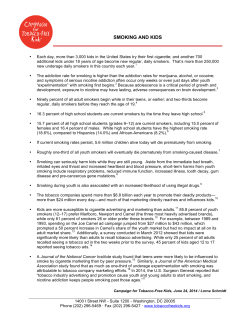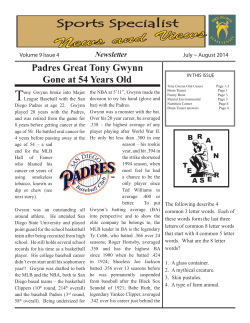
Do You? Role Models Don’t Dip Or Chew—
Role Models Don’t Dip Or Chew— Do You? National Federation of State High School Associations Role Models Don’t Dip Or Chew—Do You? A guide to help the high school coach or athletic administrator overcome a spit tobacco addiction Publisher Robert F. Kanaby Editor Lois Charley Special Projects Coordinator John Heeney Resource Center Coordinator Susan Reineke Advisory Committee Dr. Bruce Barker University of Missouri Kansas City, School of Dentistry Jimmy Coats Assistant Executive Director, Arkansas Activities Association Bob J. Crow Executive Director, Amon G. Carter Foundation Mary Daum National Institute of Dental Research Dr. Sherry Mills National Cancer Institute Jan Pannett Assistant Executive Secretary, West Virginia Secondary School Activities Commission Don Sparks Assistant Director, National Federation of State High School Associations Funding for development and distribution of this publication was provided by: Amon G. Carter Foundation National Institute of Dental Research National Cancer Institute Victor E. Speas Foundation, Administered by Boatmen’s First National Bank of Kansas City, Missouri Lois and Brice B. Durbin 2 Role Models Don’t Dip Or Chew— Do You? A Guide to help the high school coach or athletic administrator overcome a spit tobacco addiction TABLE OF CONTENTS Overview………………………………………. 4 Coaches as Role Models………………………. 5 Student Comments…………………………… 6 The Response to Spit Tobacco Use in Sports… 8 The Dangers of Spit Tobacco…………………10 The Line-Up for Quitting……………………... 11 Quitting Spit Tobacco/Tips for Going The Distance…………………………………..12 Line-Up Sheets for a Winning Strategy………13 Other Resources……………………………... 14 8 1995 National Federation of State High School Associations P.O. Box 20626, 11724 NW Plaza Circle Kansas City, MO 64195-0626 (816) 464-5400 Reprinted with permission of the National Federation of High Schools, 2007 3 Overview Spit Tobacco: Snuff and Chew Spit tobacco, also called smokeless tobacco, comes in two forms: snuff and chew. Snuff is a finely ground tobacco. Users put a pinch of snuff (called a dip or rub) next to the gum and hold it there. Chewing tobacco is bulkier and, as its name suggests, is chewed. The Dangers of Spit Tobacco Spit Tobacco Causes Health Problems. Spit tobacco use can cause permanent gum recession, mouth sores and mouth cancer. (More on these conditions later.) Spit Tobacco Is Addictive. Spit tobacco is addictive because it contains nicotine, the same drug that makes cigarettes addictive. If you hold an average size dip or chew in your mouth for 30 minutes, you get as much nicotine as you do from two to three cigarettes. Spit Tobacco Advertising The Comprehensive Smokeless Tobacco Health Education Act of 1986 prohibits radio and television advertising of smokeless tobacco products and requires warning labels on all product packages. However, symbols of tobacco products continue to be visible at organized sports, recreation and entertainment events. The use of spit tobacco by professional athletes, coaches and celebrities leads youth to believe it is socially acceptable. They may even think “everyone is doing it.” In fact, only a small percentage of Americans regularly use spit tobacco (nationally, about 5-6 percent of adult males and 1-3 percent of females, compared to 25 percent of adults who smoke cigarettes). 4 Coaches as Role Models As a high school coach, you are a role model for the young men or women on your team. You have many opportunities to influence your athletes. They listen to what you say and watch what you do (on and off the field). You many even have more clout than their parents. You can help instill values, sportsmanship and healthy behaviors in your student-athletes that will serve them well throughout their lives. As a coach, you set forth the rules of conduct for your team. The rules include “no use of alcohol, tobacco or other drugs.” Unfortunately, young athletes may underestimate the health risks of spit tobacco use. They see professional athletes—or even their own coaches—dipping and chewing. They are also exposed to the tobacco industry’s promotion of smokeless tobacco as a safe alternative to cigarette smoking. The truth is that spit tobacco contains chemicals that damage the tissues of the mouth and throat and can cause cancer. By steering your student-athletes away from spit tobacco, you are helping them avoid a potentially dangerous addiction. Your efforts may be undermined, however, if you are a user. If you dip or chew and want to quit, this publication will guide you. In the meantime, we encourage you to refrain from using spit tobacco in front of your athletes or in public places where your students may see you. Your own spit tobacco habit should not prevent you from giving your students the facts about the health risks of dip and chew. If you are uncomfortable advising your athletes about spit tobacco, find another coach or teacher to talk to them. Remember, you can still set a good example. Watching you kick the “spit” habit will reinforce to your students the importance of discipline and the need to become responsible for their actions. It’s important that you recognize and accept the role you play in preventing your team members from using spit tobacco. Many young people start using tobacco because they are imitating adult role models. By setting the example of a healthy, tobacco-free lifestyle, you can have a positive influence on your athletes’ future choices. 5 Coaches and their athletes develop a special relationship. Coaches who practice healthy lifestyles have a positive impact on their athletes. “Our head baseball coach, who also teaches health courses, has shown his players the effects of smokeless tobacco. He won’t allow us to use it on the playing field and encourages us to not participate in its use off the field. I believe that he has a great effect on all of his players.” “My role models are my father and my coach. My coach demands so much respect, and he gets it because we know he won’t let us down. He cares about kids and wants to see us become better people.” 6 “I can talk to my coach about anything—problems at home or problems with a girlfriend.” “My coach sets a good example, and I know I can always depend on her for support and encouragement, athletically as well as in all aspects of my life” 7 The Response to Spit Tobacco Use in Sports Unfortunately, spit tobacco has a long association with sports, especially baseball. Some sports organizations now realize there are health dangers associated with using spit tobacco and are concerned about the message youngsters may be getting by watching professional athletes use tobacco. Many athletic organizations now ban the use of all tobacco products on and off the field. Major League Baseball has banned spit tobacco and other tobacco products for minor league players. The National Collegiate Athletic Association prohibits the use of tobacco products by student-athletes during practice and competition. A student-athlete who uses tobacco products during a practice or competition is disqualified for the remainder of that practice or competition. The use of tobacco products by coaches and game personnel also prohibited. At NCAA championships, tobacco use by any individuals on the field of play—as well as during other championship activities such as banquets, autograph sessions, press conferences and post-game interviews—is prohibited. In the sport of baseball, dugouts are considered to be on the “field of play.” Little League Baseball rule books contain a policy that “the use of tobacco and alcoholic beverages in any form is prohibited on the playing field, benches or dugout.” The Little League Anti-Spitting Tobacco Initiative includes videos and brochures to deliver the Little League anti-spit tobacco message. USA Baseball has in effect a policy that “no form of tobacco will be allowed and will be prohibited within the confines of the field for all U.S. Baseball Federation sponsored games and applicable to all personnel.” If you ask a major league player why he uses In addition, local school boards or state spit tobacco, he may tell Departments of Education have banned you it helps him play better. smoking in school buildings and at outdoor A study sponsored by the events. Schools that take a lead in banning National Institute of Dental tobacco products can make a big difference Research found no in use by young people. connection between spit tobacco use and player performance. The findings did show, however, a link between spit tobacco and an increased risk of oral health problems. 8 ` The National Federation’s Response In response to concerns over the use of tobacco products by our nation’s youth, the board of Directors of the National Federation of State High School Associations has directed all rules committees to include in their publications provisions that prohibit the use of tobacco products by student-participants, coaches and, if possible, officials during competition. One primary goal of National Federation playing rules is to promote and preserve the safety of participants. The ban of tobacco products is another step to protect students’ health and welfare. You can help in this initiative by modeling a healthy lifestyle you would be proud to have your athletes imitate. 9 The Response to Spit Tobacco Use in Sports Using spit tobacco can cause gum recession, mouth sores and mouth cancer. Gum Recession—when the gums pull away from the teeth—is not only unsightly, but can make you vulnerable to cavities on tooth roots and make your teeth sensitive. Gum recession is difficult to repair. Sores, white patches and lumps inside the mouth are signs of tissue damage caused by chewing and dipping. White patches, also called leukoplakias, can turn into cancer over time. Mouth cancer is one of the most difficult cancers to treat. It can spread to other parts of the body quickly. Surgery required to treat mouth cancer is often extensive and disfiguring. On average, only half of those with the disease will survive more than five years. The Response to Spit Tobacco Use in Sports Spit tobacco contains nicotine, an addictive drug. Once you’re hooked on it, it can be difficult to give it up. Other Negative Consequences Sense of taste and smell are decreased Bad breath Stained teeth Socially unacceptable Wastes pocket money “I’ve tried to quit, but when faced with stressful situations . . . and believe me, coaching is stressful . . . I reach for my Skoal.” Losing Statistics Fifty percent of mouth cancer victims die within five years Spit tobacco contains at least 28 cancer-causing chemicals. Spit tobacco users are about six times more likely than non-users to get mouth or throat cancer. If you hold an average-size dip or chew in your mouth for 30 minutes, you get as much nicotine as from smoking two to three cigarettes. 10 The Line-Up for Quitting The best way to break the spit tobacco habit is to have a quit date and a quitting plan. Quitting on the spur of the moment without a plan is harder. Quitting “cold turkey” is easier when you’re prepared. The flowing section will give you some tips on how to quit dipping or chewing. Preparing to Quit Think of the reasons you want to quit. These examples may help. I am concerned about the health risks. I don’t want tobacco to control me. My doctor or dentist told me to quit. I want to be a better role model. My spouse hates it. I have sores or white patches in my mouth. I want to save the money spent on dip and chew. Pick a Quit Date Decide on a quit date. Give yourself at least a week to get prepared, but don’t wait longer than a month. It may be easier to quit during a low-stress time—spring or fall training, the off-season or early in the season. Getting Ready In the week or so before your quit date, start cutting back. Take note of the places and activities that trigger your urge to dip or chew and stop using at those times. If you normally reach for tobacco after a meal, for example, do something else instead. If you can’t give it up completely, try waiting at least 10 minutes before you put the tobacco in your mouth. Other tips for cutting back include: Delay your first dip or chew of the day. Count the number of times you dip or chew each day and taper down until you reach your quit date. Keep the dip or chew in your mouth for less time. Substitute sunflower seeds or sugar-free gum or candies for spit tobacco. Switch to mint snuff that contains 100 percent ground-up mint leaves . . . and no tobacco. Talk to your dentist or physician about nicotine gum or patches. 11 include: Quitting Spit Tobacco You will experience symptoms of nicotine withdrawal when you stop using spit tobacco. The good news is that the symptoms don’t last long. Withdrawal is strongest the first week after you quit, and the worst is over after two weeks. There are ways to help yourself through this difficult time. When you get the urge to dip or chew, wait it out. Each urge lasts only 3-5 minutes. Deep breathing can help you feel better. Take four slow, deep breaths in through your nose and out through your mouth. Engage in physical activity to fight off the edginess and irritability. Reach for substitutes such as sunflower seeds, sugar-free gum or snack foods when you would normally use tobacco. Stick with low-calorie snacks if you’re worried about gaining weight. Drink lots of water—up to eight glasses a day. Talk to someone who can offer support and encouragement. Two weeks off spit tobacco will break your physical dependence on nicotine. If you can stay off that long, you can stay off forever. You will probably still feel urges to use, particularly in situations where you used to dip or chew. Tips for Going the Distance Use what worked best for you when you first quit, whether it was exercise, substitutes, deep breathing or something else. If you associate finishing a meal with dip or chew, brush your teeth immediately after eating. Keep tobacco and spitting cups out of sight. Visit your dentist and have your teeth cleaned. Collect the money you normally would have spent on tobacco; notice how it adds up. If you do slip, don’t feel like you’ve failed. Pick up right where you left off before the slip. If you find yourself dipping or chewing on a regular basis, figure out what didn’t work and make a new quitting plan. 12 Tips for Going the Distance My quit date is: I want to quit using spit tobacco because: I’ll try these things when I get the urge to dip or chew: I’ll call these people for support when I get the urge to dip or chew: 13 You’ve Made It! Reaching for your dip or chew first thing in the morning is on longer a part of your life. Your sense of taste and smell have improved. You’ve reduced your risk of mouth sores, gum recession and mouth cancer. And there’s even some extra money. Your students will probably notice, too, that you don’t have to carry your “spit” cup with you and you feel more comfortable as a role model. You are now able to share the tips that worked for you with your athletes who chew. The message you are sending to your athletes is positive and you are now in a better position to educate students about the health risks of spit tobacco use. For further information on spit tobacco, you may wish to contact: American Cancer Society 1-800-ACS-2345 American Academy of Otolaryngology “Through With Chew” One Prince Street Alexandria, VA 22314 Cancer Information Service National Cancer Institute 1-800-4-CANCER (1-800-422-6237) National Clearinghouse for Alcohol and Drug Information 1-800-729-6686 For spit tobacco posters: National Oral Health Information Clearinghouse (301) 402-7364 Additional copies of this publication are available from the National Federation TARGET Program, the Healthy lifestyles service of the National Federation of State High School Associations. Call the National Federation TARGET Program at (816) 464-5400 for prices and ordering information. Other smokeless tobacco videos/publications from TARGET include: Smokeless Tobacco: Is It Worth the Risk? This 13-minute video points out the consequences of continued smokeless tobacco use. The Spitting Image Teleconference This two-hour video was designed to help state athletic and activity associations, school administrators and coaches use their influence to prevent young people from using smokeless tobacco. The Spitting Image: Is Chewing Tobacco a Part of the Game? This brochure gives student-athletes the benefits of being “spit-free.” 14
© Copyright 2026


